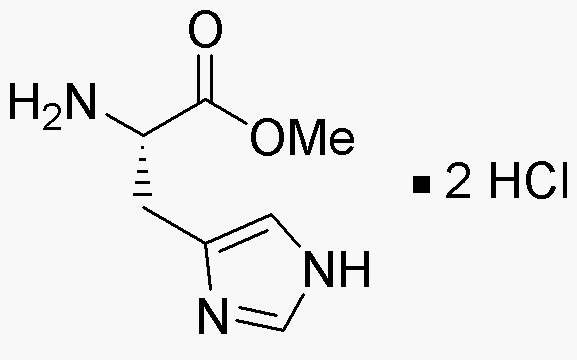L-Histidine methyl ester dihydrochloride is widely utilized in research focused on:
- Biochemical Research: It serves as a substrate in enzymatic assays, helping researchers study enzyme kinetics and mechanisms, particularly those involving histidine residues.
- Pharmaceutical Development: This compound is used in drug formulation processes, especially for creating histidine-rich peptides that can enhance drug stability and efficacy.
- Nutrition and Dietary Supplements: It is incorporated into supplements aimed at improving muscle recovery and overall metabolic health, leveraging its role in protein synthesis.
- Cell Culture Media: L-Histidine methyl ester dihydrochloride is added to cell culture media to support the growth of various cell lines, providing essential nutrients for optimal cell proliferation.
- Research on Neurotransmitters: It is utilized in studies investigating the role of histidine in neurotransmitter synthesis, potentially leading to insights into neurological disorders.
General Information
Properties
Safety and Regulations
Applications
L-Histidine methyl ester dihydrochloride is widely utilized in research focused on:
- Biochemical Research: It serves as a substrate in enzymatic assays, helping researchers study enzyme kinetics and mechanisms, particularly those involving histidine residues.
- Pharmaceutical Development: This compound is used in drug formulation processes, especially for creating histidine-rich peptides that can enhance drug stability and efficacy.
- Nutrition and Dietary Supplements: It is incorporated into supplements aimed at improving muscle recovery and overall metabolic health, leveraging its role in protein synthesis.
- Cell Culture Media: L-Histidine methyl ester dihydrochloride is added to cell culture media to support the growth of various cell lines, providing essential nutrients for optimal cell proliferation.
- Research on Neurotransmitters: It is utilized in studies investigating the role of histidine in neurotransmitter synthesis, potentially leading to insights into neurological disorders.
Documents
Safety Data Sheets (SDS)
The SDS provides comprehensive safety information on handling, storage, and disposal of the product.
Product Specification (PS)
The PS provides a comprehensive breakdown of the product’s properties, including chemical composition, physical state, purity, and storage requirements. It also details acceptable quality ranges and the product's intended applications.
Certificates of Analysis (COA)
Search for Certificates of Analysis (COA) by entering the products Lot Number. Lot and Batch Numbers can be found on a product’s label following the words ‘Lot’ or ‘Batch’.
*Catalog Number
*Lot Number
Certificates Of Origin (COO)
This COO confirms the country where the product was manufactured, and also details the materials and components used in it and whether it is derived from natural, synthetic, or other specific sources. This certificate may be required for customs, trade, and regulatory compliance.
*Catalog Number
*Lot Number
Safety Data Sheets (SDS)
The SDS provides comprehensive safety information on handling, storage, and disposal of the product.
DownloadProduct Specification (PS)
The PS provides a comprehensive breakdown of the product’s properties, including chemical composition, physical state, purity, and storage requirements. It also details acceptable quality ranges and the product's intended applications.
DownloadCertificates of Analysis (COA)
Search for Certificates of Analysis (COA) by entering the products Lot Number. Lot and Batch Numbers can be found on a product’s label following the words ‘Lot’ or ‘Batch’.
*Catalog Number
*Lot Number
Certificates Of Origin (COO)
This COO confirms the country where the product was manufactured, and also details the materials and components used in it and whether it is derived from natural, synthetic, or other specific sources. This certificate may be required for customs, trade, and regulatory compliance.


